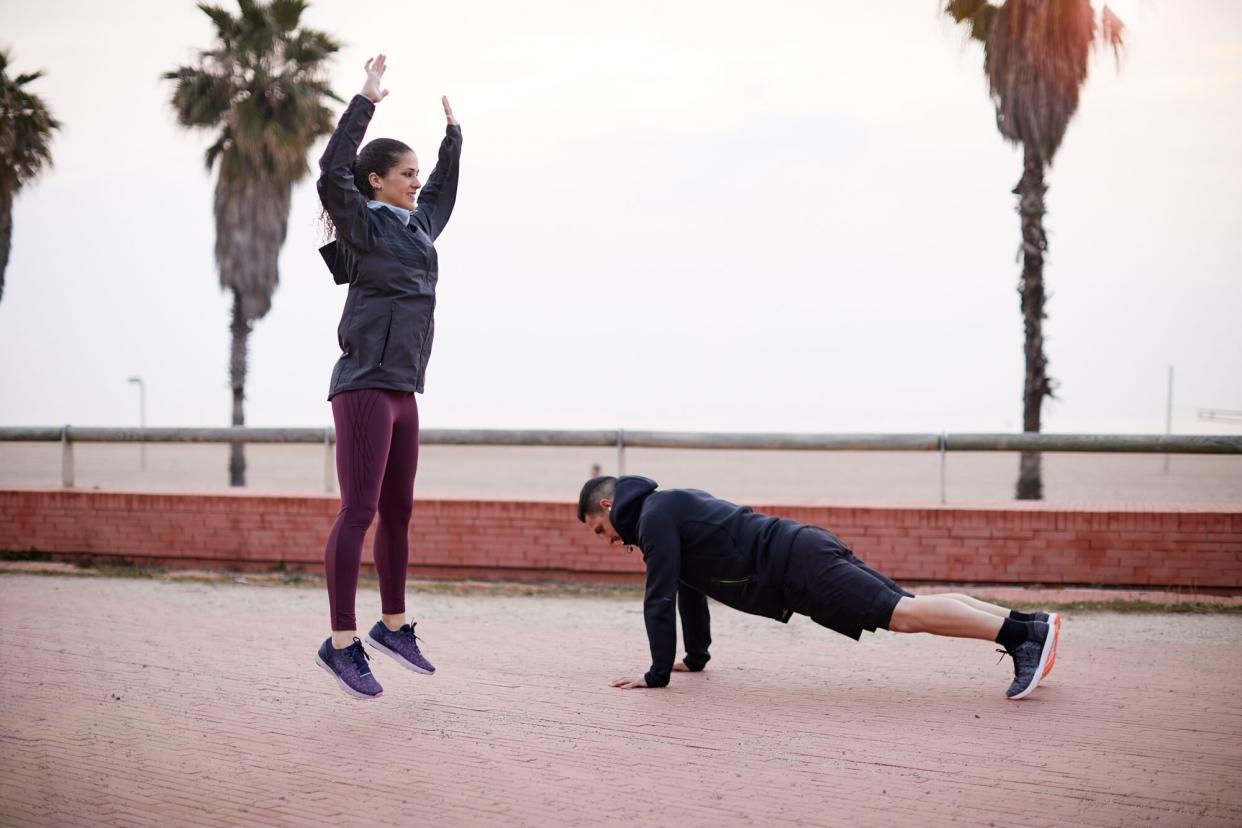Here's How to Do a Perfect Burpee, According to Trainers

Getty Images
If you’ve ever set foot in a CrossFit gym, taken a bootcamp class, or followed a fitness influencer on Instagram, you’re probably familiar with burpees. They’re an exercise people love to hate, since after enough reps, they tend to induce that lung-burning, throw-up-in-your-mouth feeling.
That’s one of the reasons many trainers put them in their workout programs. “Burpees are an awesome total -body, compound exercise that is great for building strength and endurance,” explains Zarina Briggs, a certified personal trainer and founding trainer at Kuudose.
Because they’re so intense, burpees are ideal for taking advantage of a phenomenon known as excess post-exercise oxygen consumption (EPOC), where your body continues to burn calories long after your workout. This effect happens when you do an intense workout that gets your heart rate high. Of course, there are many other ways to achieve this effect, but burpees are a fast, equipment-free way to boost your workout’s intensity.
RELATED: If You Hate Doing Cardio, You Can Probably Stop
How to Do a Burpee, Step-by-Step
Step 1: Standing to plank
Bend your knees, almost like you’re going to do a squat, and place your hands on the floor underneath your shoulders. Once your hands are on the ground, hop your feet back into a plank. Don’t slam your hands onto the ground; try to be as gentle about it as you can. “Landing with too much impact can strain your wrists, elbows, and shoulders,” Briggs says.
Step 2: Plank to floor
Squeeze your glutes (this helps keep your core engaged) and keep your neck in a neutral position as you lower your body to the floor.
As you do more repetitions and start to get tired, you might notice you start dropping your hips to the ground before the rest of your body. This can put stress on your lower back, according to Briggs, so try to keep your whole body in a straight line as you make your way to the floor.
Step 3: Floor to squat to hop
Start to press yourself up, again keeping your body in a straight line. “Avoid peeling yourself off the ground by lifting your chest first and leaving your hips on the floor,” Briggs advises. This causes an excessive arch in your lower back which can lead to injury and back pain.
Jump your feet forward to a little wider than hip-width distance, coming into a squat position. From here, hop straight up off the ground, reaching your hands towards the ceiling and clapping. Bend your knees slightly as you land to protect your knees and ankles.
What else should you know about burpees?
If you have certain injuries, avoid them.
Burpees are a high-impact movement, meaning the potential for injury is higher than with other exercises — especially as you get fatigued. People with existing injuries, such as ACL, PCL, and MCL injuries should avoid burpees, according to Anthony Crouchelli, CFSC, Master/Founding Trainer at Grit Boxing. “Also, if you have a previous wrist injury or weak wrists, you should also avoid doing burpees at full speed.”
Use them in the right context.
Crouchelli usually programs burpees as a workout finisher — a quick burst of high-intensity work at the end of a workout — or as part of an every minute on the minute (EMOM) workout. EMOMs involve a series of movements that need to be performed every minute, using any remaining time left over before the next minute starts to rest. These two types of workouts have something in common: They’re generally short. That’s a plus: Burpees aren’t the kind of thing you want to be doing for 40 minutes straight.
RELATED: How to Ease Back Into Working Out Again, According to Trainers
Good form really is key.
“Injuries mainly occur in this movement when people slam their wrists into the floor or experience discomfort when rounding their lower back throughout the pattern,” Crouchelli says. This is why he emphasizes form with his clients who are performing burpees: “It’s imperative to be mindful of your movements, especially ones that err of the higher end of the impact spectrum.”
Not all trainers love them.
Some trainers specifically avoid burpees in their workouts with clients. Celebrity trainer Ben Bruno is a great example. His reasoning? They’re an advanced movement, often taught to beginners, with a high risk of injury. That doesn’t mean you should never, ever do burpees if you like doing them. But to Bruno’s point, you can certainly have a great workout and/or get super fit without ever doing burpees.
Don’t overdo it.
“Burpees are undoubtedly a great exercise to increase the intensity of a workout, however, they can be taxing on the body,” Crouchelli says. Because of this, he often mixes them or alternates them with other movements, like plank-walk outs or plank up-downs. “These are both great alternative exercises that help you build your muscular endurance while breaking a sweat!”

